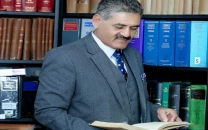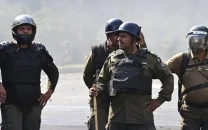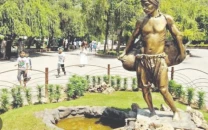On surprise Kabul visit, army chief discusses peace process
During his stay in Kabul, Gen Raheel met President Ashraf Ghani and held separate talks with US military leadership

Gen Raheel poses with President Ghani at the Presidential Palace in Kabul. PHOTO: APP
Army chief General Raheel Sharif paid an unannounced visit to Afghanistan on Wednesday to give final touches to planned resumption of direct talks between the representatives of Afghan government and the Taliban.
Gen Raheel made a stopover in Kabul while returning from Tajikistan to attend the change of command of Nato’s Resolute Support mission in Afghanistan. US General John W Nicholson took over command of the mission from Gen John Campbell.
During his stay in Kabul, Gen Raheel met President Ashraf Ghani and held separate talks with US military leadership.
“These meetings reviewed the reconciliation process being pursued through the ongoing QCG [Quadrilateral Coordination Group] framework,” the Inter-Services Public Relations (ISPR) said in a statement after the meetings.
“The chief of the army staff reiterated whole-hearted support to the Afghan leadership for peace, and stability in Afghanistan,” DG ISPR Lt Gen Asim Saleem Bajwa said.
Both the army chief and the Afghan president expressed their optimism for a positive outcome of the reconciliation process being pursued through the QCG framework. The group, comprising Pakistan, Afghanistan, China and the United States, announced in its last meeting held in Kabul resumption of direct talks in the first week of March. Pakistan will host the first round.
The Afghan leadership also acknowledged Pakistan Army’s efforts and achievements in the war against terrorism and its role for regional peace and stability.
A security official told The Express Tribune on condition of anonymity that the army chief travelled to Kabul to give ‘final touches’ to the planned direct talks. All Taliban groups as well as Hizb-e-Islami have been invited to the peace talks.
The army chief also met top US military leadership, including Chairman of the Joint Chiefs of Staff (CJCS) Gen Joseph Dunford, Commander US Central Command (Centcom) Gen Lloyd J Austin and Gen Nicholson.
Lt Gen Bajwa said on Twitter that the discussion focused on regional security, border management and coordination to check terrorists trying to flee the final phase of the North Waziristan operation in Shawal Valley.
At the change of command ceremony, Gen Campbell singled out Gen Raheel for praise due to his role to ensure regional peace.
“Gen Raheel, thank you for travelling here and being such an important part of regional security,” Campbell said in his farewell speech. Speaking to reporters after the ceremony, he praised Pakistan’s counter-terrorism operations under Gen Raheel’s leadership.
“They have got a very tough fight in Pakistan. Many Pakistani soldiers, police officials and civilians have died because of terrorism. He [Gen Raheel] made some very courageous decisions in the summer of 2014 to undertake concerted efforts in many areas that no other leader would have gone to in Pakistan to drive out terrorists.”
Referring to his close relationship with the Pakistani army chief while commanding foreign troops in Afghanistan, Campbell said he discussed with Gen Raheel how Pakistan and Afghanistan could improve their joint efforts against terrorism.
Regarding peace talks, the outgoing Nato commander urged the Taliban to join the reconciliation process. “My message to the Taliban is again: put down your arms, come and talk to Afghanistan and be part of the political process.”
Campbell’s successor Gen Nicholson also called upon the Taliban to give up arms. “You [Taliban] have brought only hardship and suffering to the Afghan people. It is time for this to end, time for you to lay down your arms and join the future,” he said.
Published in The Express Tribune, March 3rd, 2016.



















COMMENTS
Comments are moderated and generally will be posted if they are on-topic and not abusive.
For more information, please see our Comments FAQ